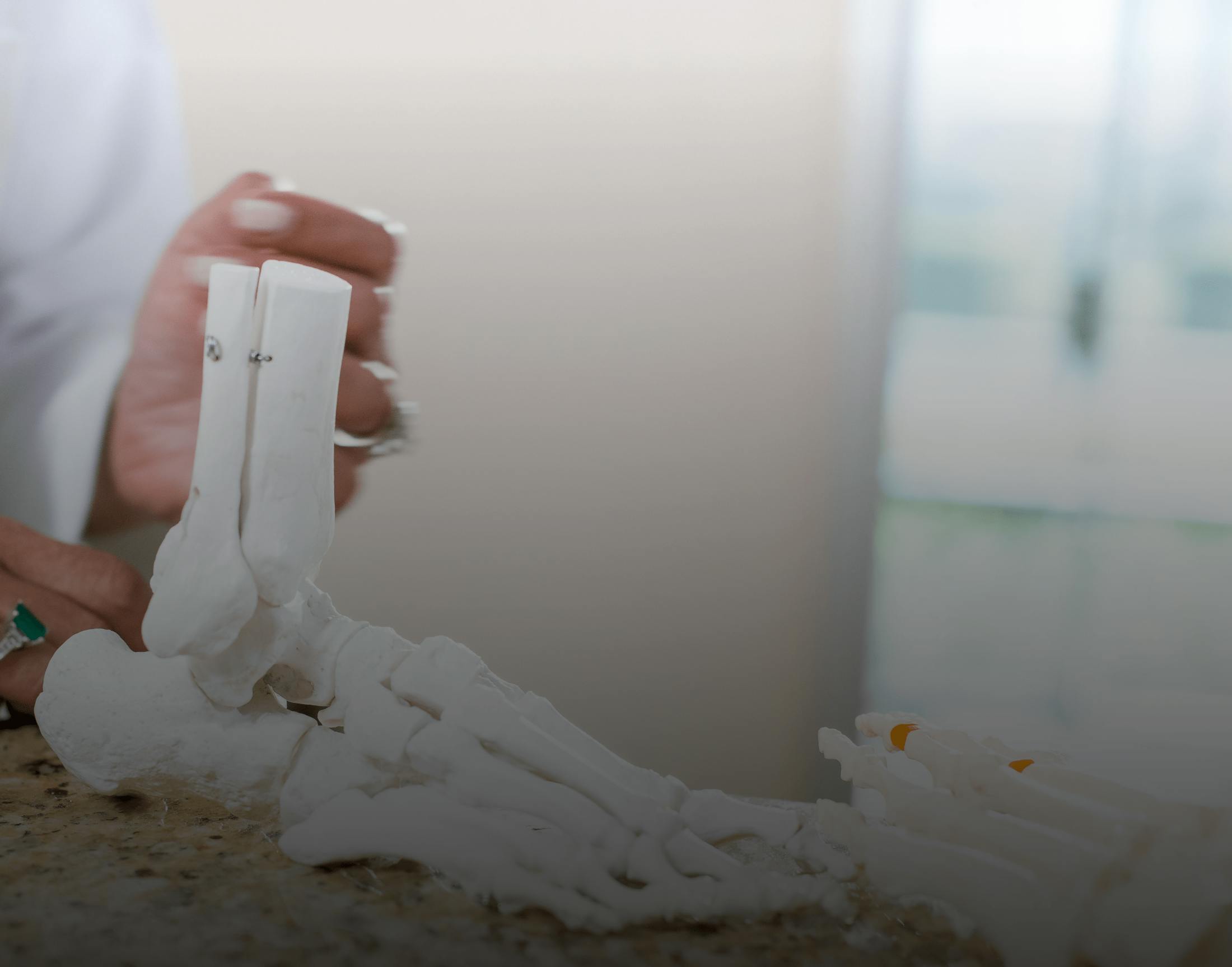Schedule a Consultation
Contact Us



Nearly any form of trauma or stress can lead to a fracture — and for those with certain medical conditions, even minor impacts can lead to serious fractures.
While all fractures involve a break in the bone, the properties of fractures can vary significantly. This has led to specific names for the different types of breaks. Some of them overlap, as they describe different aspects of the break:
There are several non-surgical solutions for stable or minor foot and ankle fractures that you can manage at home. Common treatments include wearing a cast or boot, pain management, and RICE therapy (Rest, Ice, Compression, and Elevation). At Foot and Ankle Specialty Group Inc., we offer the following non-surgical treatment options for fractures:
For more severe or complex foot and ankle fractures in Newport Beach, surgical intervention may be necessary to ensure proper healing and restore function. At Foot and Ankle Specialty Group Inc., we specialize in the following advanced surgical techniques to effectively treat fractures and support long-term recovery:
People are often unsure whether they’ve sprained or fractured their foot or ankle. Understanding the difference helps ensure proper treatment and faster recovery. If you experience ankle pain, swelling, or bruising after an injury, it’s best to seek professional evaluation. Whether your experiencing an sprain or ankle fracture in Newport Beach, Foot & Ankle Specialty Group uses imaging and thorough assessment to accurately diagnose your injury and recommend the right treatment plan.
While it’s impossible to eliminate all risk of ankle or foot fractures in Newport Beach, it’s important to understand what risk you’re at, as well as what activities and health decisions increase or decrease that risk.
Cortisone medications and some others can weaken bones and cause tearing, while other medications can make you more likely to suffer a fall or accident.
A history of stress fractures can increase your likelihood of experiencing them in the same bone, as can incomplete healing of other types of fracture.
Low vitamin D and calcium can lead to decreased bone density, making it easier to break bones.
Generally speaking, your likelihood of a fracture given a particular impact or stress event increases with age. Beyond that, certain fracture types and particular fractures change in likelihood at different ages (such as greenstick fractures, buckle fractures, and growth plate fractures in children).
Tobacco and alcohol both interfere with the formation and maintenance of bone.
Even relatively benign abnormalities in a bone can make it easier to break, due to changes in how pressure is distributed under load.



If you're dealing with foot or ankle fractures, it's essential to seek care from a team that combines clinical expertise with a patient-centered approach. At Foot & Ankle Specialty Group, we offer advanced diagnostic tools and personalized treatment plans to help patients recover efficiently and comfortably. Our goal is to relieve pain, restore mobility, and prevent long-term complications.
For trusted care for foot and ankle fractures in Newport Beach, our clinic has been serving the community since 2001. Dr. Salma Aziz, Dr. Petrina Yokay, and Dr. Jessica Arneson are experienced female physicians known for delivering high-quality, compassionate care in a welcoming environment. We treat everything from minor fractures to complex injuries using both traditional and innovative methods. Contact us today to learn more or schedule your consultation.
How do I know if I have a foot or ankle fracture?
Will I need physical therapy after my fracture heals?
Can I treat my fracture at home?
What is the recovery time for foot and ankle fractures?
Ankle fracture vs ankle sprain?
Common signs include sudden pain after trauma, swelling, bruising, difficulty bearing weight, or a visible deformity. If you have any of these symptoms, seek evaluation promptly to determine if it’s a fracture or a sprain.
In many cases, yes. Physical therapy helps restore strength, flexibility, and balance. It’s particularly important if you’ve been immobile or used a cast, as it helps rebuild muscle and joint function.
Treating a foot or ankle fracture at home involves several important steps to manage pain and swelling while awaiting professional care. You must remember (R.I.C.E) rest, ice, compression, and elevation. First, rest is crucial—avoid putting weight on the injured foot or ankle to prevent further damage. Apply ice packs for 15–20 minutes every 1–2 hours during the first 48 hours to reduce swelling and pain, ensuring the ice is wrapped in a towel to avoid frostbite. Compression with an elastic bandage can help control swelling, but it should not be too tight, as it can restrict blood flow. Elevating the foot or ankle above heart level whenever possible also aids in reducing swelling. If a fracture is suspected, immobilize the area using a splint or a makeshift brace to prevent movement, and avoid walking or bearing weight on the injured foot. Over-the-counter pain relievers like ibuprofen or acetaminophen can help manage discomfort, but always follow recommended dosages. While these steps can help in the short term, seeking medical attention is essential for an accurate diagnosis and appropriate treatment, such as casting or surgery, to ensure proper healing and avoid complications.
The recovery time for foot and ankle fractures can vary depending on the severity of the fracture, treatment method, and individual health. Minor fractures, like hairline fractures, typically heal in 6–8 weeks with rest, ice, compression, and elevation, along with protection from a cast or boot. Moderate fractures, such as displaced fractures or those requiring surgery, usually take 8–12 weeks to heal, with possible extended recovery if surgery is involved. Severe fractures, including compound fractures or those involving joint damage, may require 12 weeks or longer for recovery, with intensive treatments such as surgery, physical therapy, and a gradual return to activity. Age, overall health, and the specific location of the fracture can also affect healing time. Older adults or individuals with conditions like osteoporosis or diabetes may take longer to heal. In cases of complications such as infections or delayed healing, the recovery process could be further prolonged. Following the guidance of your healthcare provider is crucial for optimal recovery.
An ankle fracture involves a break in one or more bones of the ankle, usually caused by trauma. It results in severe pain, swelling, bruising, and difficulty moving the ankle, and often requires a cast, boot, or surgery for treatment. An ankle sprain is a ligament injury caused by twisting or rolling the ankle. It leads to pain, swelling, bruising, and limited movement but does not involve broken bones. Treatment typically involves rest, ice, compression, and elevation (R.I.C.E.), with more severe sprains possibly requiring a brace or physical therapy.